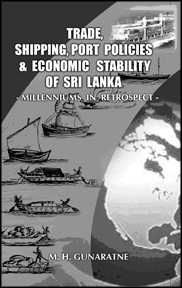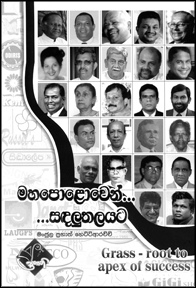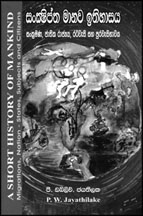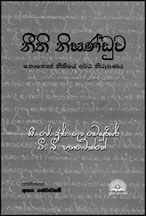
Guide to Lanka's Trade, Shipping and Port Policies
Reviewed by Don Wijewardene, International
Consultant

Trade, Shipping, Port Policies & Economic
Stability of Sri Lanka-
Millenniums In Retrospect
Author: Dr. M.H. Gunaratne
Publisher: Stamford Lake
Pages:370
Price: Rs 1000
|
The main objective of the Study is to bring out the need for a
synergy of trade, shipping and port policies of Sri Lanka in maximising
the advantages of its geographical location for sectoral benefits and
the benefit of the country at large as an action oriented strategy for
the future.
Promotion of synergy between trade, shipping and port related
activities had transcended in the development of a distinctive maritime
and navigational tradition of the people and the elevation of ports to
centres of entrepot trade through the ancient and medieval phases of Sri
Lanka's history. When power was shared between the Portuguese, Dutch and
the local kings synergy was partly cohesive whilst during the period of
the British occupation the selected paradigm was justified as an
economic necessity. It is apparent that every local ruler emulated a
common policy irrespective of time span on account of its pervasive
effects.
Country's favourable location at the tip of the Indian sub-continent
in proximity to major East-West shipping lanes continues to intertwine
Lanka with India as a gateway for trade and related activities and the
western world as a shipping hub The common thread that binds the
relationship is entrepot trade or distribution system. The inherent
resilience to international and regional events to sustain the
distinctive character has been an invaluable dimension of the country's
hallowed maritime tradition.
The methodology used in capturing the synergy in operation is both
deductive and inductive as secondary information has been used to
capture the past whilst the futuristic scenarios have been based on
primary sources. The quintessence of the findings had manifested in the
development of entrepot trade, value addition in trading activity
supplemented by export of multifarious items in a strategic partnership
with the outside maritime world. In the modern context of globalisation
the strategy remains highly tenable for application
Entrepot trade is defined lucidly in the modern context as exporting
goods of other countries through value addition or simply re-exporting
at the right time after a period of storage for value addition. Value
added services identified with entrepot trade in the modern context
inter alia include:Quality Control, Repacking, Customizing, Assembly,
Testing, Repair, Re-use, Storage for re-export etc.
Some of these activities were practised in the ancient period
particularly at Mantota (North West Sri Lanka) when Anuradhapura was the
capital (377BC-1070AD) for over half a millennium as an acknowledged
entrepot port in East-West trade. (Brohier) The book make reference to
Sri Lanka's involvement in transmitting merchandise between East and
West a role once played by Western India (Christiana) and the creation
of a truly national marine by Moggalana1 (491 509AD ) for ensuring
security with the growing position as a regional shipping hub whilst
Romans making a direct call. (Tennent) After the fall of Alexandria 638
AD the hub position ceased to exist resulting in the shift of capitals
and trading practices.
The rulers pre-occupation with trade generated at all ports of the
Island is corroborated by inscriptional evidence which further indicates
the primacy reached by Galle in the medieval period to interface
international trade Mayura Sandesaya 1385-1391 AD (Respected Book of
Verses) eulogises on the existence of several western coastal ports as
entrepot centres during the medieval period.
For over 300 years when the country was under European domination
entrepot was practised as an inherent part of the country's commercial
regimes.
As a practical justification for the theory that is investigated ,the
elevation of the Colombo Port to attain the twenty fourth place among
the container handling ports of the world in the 1990's has been
analysed bringing out the demand conditions. In order to sustain the
position in the context of rapidly growing transshipment, the need to
combine equipment capability enhancement to handle with state of
-the-art Information
As a natural corollary of the development, the launch of the Colombo
Freeport Project directly related to the promotion of Port's and also
Airport's supply chain functions including value addition at the highest
global level has been examined.
The arrival at this milieu has been a challenging task for an
emerging nation whilst sustaining the position will be still arduous .In
order to confront the future judiciously, benchmarks established during
the historical phases including theoretical positions of the different
eras are presented to familiarize policy makers. As for the future
comparative information from a widest possible domain has been invoked
to sustain a niche in competitiveness whilst implementing policies.
The theme that is expounded in a continuum as an integral part of
entrepot is the daring role of national shipping and a resemblance that
is drawn between various phases of the chronology. The great heights of
this episode excluding the protectionist phase of 1970's was reached
when national shipping played an overwhelming role during the British
phase of history.
In the final analysis attention is focused on a new and metamorphosed
milieu in maritime affairs in Sri Lanka brought about by the convergence
of national and international developments.
With the introduction of Post-Panamax vessels 1988 upsizing of
vessels continued and to prevent ship operating cost benefits being
eroded pressure was exerted to improve cargo handling performance.
In providing a visionary perspective for the future the need to
develop national merchant marines not necessarily Government owned has
been emphasized both for bulk, break bulk, coastal and container feeder
operation in an environment dominated by Mega carriers. To retain the
services of Mega Carriers undiminished at Colombo, value additions in
the Colombo port ,enhanced entrepot trade and exports (captive cargoes)
are examined in the backdrop of competitive ports and volatility in
transshipment. In this context a Freeport area is implied to extend from
Colombo Port to Katunayake Airport providing an integrated air, sea
operation. It is suggested that the development of regional ports in the
Island should be on their unique comparative advantage according to
foreign and local demand.
This has elevated the book to the role model imbibing strong national
sentiments whilst highlighting economic benefits.
A continuous story over a long period is easily readable in view of
the facilitation adroitly provided by the coherent arrangement of short
sub titles under each of the eight Chapter headings. The narrative is
embellished by Tables (9) Annexure (10) Diagrams (8) Maps (8) Pictures
(1) providing the supporting wealth of authoritative information
obtained from authentic sources.
Tips to achieve success
|

Maha Polowen Sandalu Thalayata
(Grass-root to apex of success)
Author: Manjula Prabhath Hettiarachchi Prabhani Publications,
Malwana,
Rs. 800
|
|

Manjula Prabhath Hettiarachchi
|
Contains ten moving stories of outstanding businessmen who could
reach lofty heights in their careers through self-determination and hard
work. Twenty five articles have been updated and selected for the book
by Manjula Prabath Hettiarachchi, out of over hundred stories which he
compiled to "Aratuwa" under the title "Influential Business
Personalities in Sri Lanka" from 2000-2004.
The book contains success stories of award winning business
personalities such as Victor Hettigoda, Ajith Wijetunga, Camillus Perera,
Hemachandra, Wagapitiya, Amal Karunathileke, Ms. Janet Balasuriya,
Lawrence Perera, Odiris Perera, Gamini Saparamadu, Russell Francis
Perera, Ariyaseela de Silva Wickramanayake, Ms. Mallika Hemachandra,
Sarath Padmalal, Kashyapa Mahendra de Silva, Daya Dharmapala Gamage,
Aruna Upul Jayasinghe, Dayawansa Jayakody, Asoka Jayalath Wimaladharma,
Dayananda Gunewardena, Sarathchandra de Silva, Dharmachandra Nimalasiri,
Narayana Nandadasa, Mayilwaganam Rajkumar, Milton de Silva Galappaththi
and Sunil Rathnayake. Their contribution to the business field is
immense and what the author appreciates is their courage and undying
determination. The book contains all the relevant details of their life
stories from their early beginnings. At the end of each story their
Curriculum Vitae too has been attached in order to help readers get the
maximum knowledge about them. Manjula says he wants people particularly
those who aspire to become business giants, to gain inspiration from
those personalities. Unlike most of the writers who focus on
international business icons, Manjula's attempt is to set an example to
young entrepreneurs through highlighting outstanding local businessmen.
The author believes that going through such biographies would help many
people shed pessimism which stands as a hindrance when achieving
targets.
Manjula, who holds a BA (Special) in Mass Communication from the
University of Kelaniya has also worked as the Deputy Features Editor of
"Irida" newspaper and Deputy Editor of "Aratuwa". He is currently the
Editor-in-Chief of "Diriya", a magazine for business women.
"Sanda Madala Gini Ganee" is his debut anthology.
|

Author: A.A.M. Fazi, (BA, Eng. Sp. Trd.)
Published by
S.B.H. Publications, No. 77,
Dematagoda Rd, Colombo 09.
Price: Rs. 225 |
English Grammar for You
Reviewed by K.T. Silva,
Principal, of Lyceum International School, Ratnapura,
A book on English Grammar, authored by A.A.M. Fazi of R/ Hindu
College, Balangoda, an invaluable aid, a self study guide and an ideal
reference book for any one who is interested in English Language, was
launched recently at Jeilany National School of Balangoda. His maiden
publication, "English Grammar for You" was highly appreciated by the
Vice Chancellor of Sabaragamuwa University of Sri Lanka by his message
of appreciation read by Mr. Sivayesurasa, Senior Lecturer of English of
Sabaragamuwa University of Sri Lanka.
The book also talks about word
classes, Nouns, Verbs, Adjectives, Pronouns, Proforms, Adverbials,
Prepositions, Quantifiers, Determiners, Phrases, Clauses, Sentence
Elements, Passive Voice, Tenses and Times, Direct speech and Indirect
Speech, Uses of modals, and Capitalization etc.Abdul Azeez Mohamed Fazi
is a teacher of English at R/Hindu College, Balangoda. He is an Arts
Graduate of University of Peradeniya and he is reading for his Masters
of Arts in Sociology.
 |
Launch of two books on Buddhism
Ven. Kiribathgoda Gnanananda Thera's 'Ama Dam Rasa Vehena
Vistharartha Dhammapadaya - 6' and 'Sudumudu Buduguna Sihikara Ganne' (Sattis
Bodhi Pakshika Dharma) will be launched at the All Ceylon Buddhist
Congress hall, Bauddhaloka Mawatha, Colombo 7 on Wednesday September 30
at 4 pm.
Ven. Kiribathgoda Gnanananda Thera will also deliver a Dhamma Desana
on this occasion. |
 [ New on the shelf] [ New on the shelf]
Sankshiptha Manawa Ithihasaya
(A short history of mankind)
Author: P.W. Jayatileke
Author Publication
Rs. 400
The book contains details of formation of civilizations, Greek-Rome,
Chinese and other Eastern civilizations, ancient migrations,
nation-States, subjects and citizens.
As its title suggests the book is indeed a handbook of the history of
mankind.
Neethi Niganduva
 Neethi Niganduva originally written by C. J. R. Lemesuriyar and T. B.
Panabokke has been translated into Sinhala by Abaya Hewavasam. The book
codifies the then prevalent law in the up-country. Neethi Niganduva originally written by C. J. R. Lemesuriyar and T. B.
Panabokke has been translated into Sinhala by Abaya Hewavasam. The book
codifies the then prevalent law in the up-country.
The unabridged Sinhala version of the book gives a graphic account of
the law relating to slaves, property, marriage, divorce, custody of
children, legitimisation, adoption of children, guardianship, devolution
of property to wife and children, and rights of children.
The book is useful for practising lawyers, law students and the
general reader.
'Neethi Niganduva' is a Sooriya publication. |

